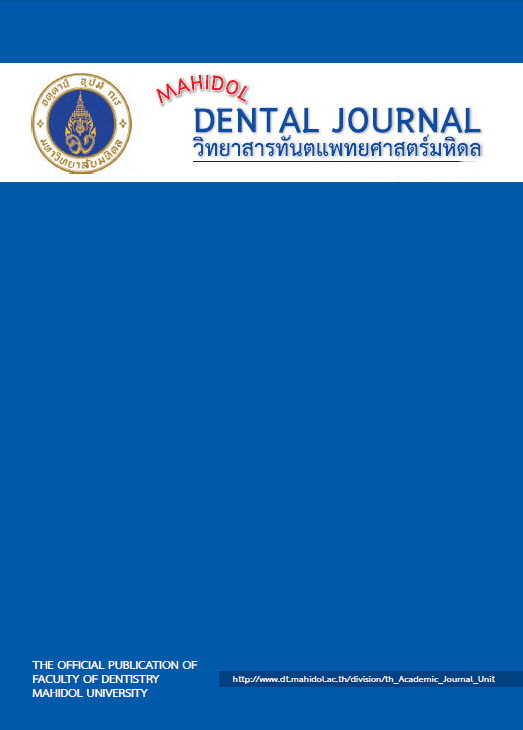The comparative study of the effectiveness of decalcifying agents on human jaws
Main Article Content
Abstract
Objective: To compare the effectiveness of five different decalcifying agents on human jaws.
Material and methods: Human jaws were collected from 6 patients. Each case was cut into 5 pieces and immersed in 5 different decalcifying agents including 5% nitric acid, 5% nitric acid +formaldehyde, 10% formic acid, neutral EDTA, and anna morse. At the end of the decalcification, samples were subjected to routine histopathological process. Decalcification time, the ease of sectioning, the staining, and structures of hard and soft tissues were evaluated and scored.
Results: In terms of decalcification time and the ease of sectioning, the evaluation scores of 5% nitric acid and 5% nitric acid + formaldehyde were higher than other agents (p< .05). 10% formic acid and anna morse gave better staining and hard tissue structure than 5% nitric acid and 5% nitric acid + formaldehyde (p< .05). All 5 agents did not show differences in the staining and structure of the soft tissue associated with the hard tissue.
Conclusion: A good decalcifying agent must have quality that is suitable for the type of work. In cases requiring urgency, 5% nitric acid and 5% nitric acid + formaldehyde may be selected. For the quality of the tissue, 10% formic acid and anna morse may be the ideal choice.
Article Details
References
2. เวคิน นพนิตย์. เทคนิคทางเนื้อเยื่อวิทยา พิมพ์ครั้งที่1. กรุงเทพมหานคร: สำนักงานพิมพ์ห้างขายยาตรานกยูง; 2524: 25-6.
3. ศุภลักษณ์ โรมรัตนพันธ์. เทคนิคเนื้อเยื่อสัตว์ พิมพ์ครั้งที่1. กรุงเทพมหานคร: สำนักพิมพ์มหาวิทยาลัยเกษตรศาสตร์; 2545: 111-2.
4. John D. Bancroft, Alan Stevens. Theory and practice of histological techniques. 4th ed. Hong Kong: Churchill Livingstone; 1996: 314-5.
5. Sanjai K, Kumarswamy J, Patil A, Papaiah L, Jayaram S, Krishnan L. Evaluation and comparison of decalcification agents on the human teeth. J Oral Maxillofac pathol 2012; 16: 222-7.
6. Callis G, Sterchi D. Decalcification of Bone : literature review and practical study of various decalcifying agents, methods, and their effects on bone histology. The journal of histotechnology 1998; 21: 49-58.
7. Grando ML, Westphalen BL, Vieira VPF, Borba AF, Medeiro FAC. Comparative analysis of two fixating and two decalcifying solutions for processing of human primary teeth with inactive dentin carious lesion. Revista odonto ciencia-fac. Odonto/PUCRS 2007; 22: 99-105.
8. Fernandes MI, Gaio EJ, Rosing CK, Oppermann RV, Rado PV. Microscopic qualitative evaluation of fixation time and decalcification media in rat maxillary periodontium. Braz Oral Res 2007; 21: 134-9.
9. Warshawsky H, Moore G. A technique for the fixation and decalcification of rat incisors for electron microscopy. J Histochem Cytochem 1967; 15: 542-9.
10. Cook SF, Ezra-cohn HE. A comparision of methods for decalcification bone. J Histochem Cytochem 1962; 10: 560-3.
11. Zappa J, Bielecka AC, Adwent M, Cieslik T, Sabat D. Comparision of different decalcification methods to hard teeth tissue morphological analysis. Dent Med Probl 2005; 42: 21-6.
12. Bourque WT, Gross M, Hall BK. A histological processing technique that preserves the intergrity of calcified tissue (Bone, Enamel), yolky amphibian embryos and growth factor antigens in skeletal tissue. J Histochem Cytochem 1993; 41: 1429-34.
13. Klincomhum A, Kengkoom K, Ampawong S. Conparative of decalcification methods for adult rat calvarium bone in relation to histomorphoogical study. Kasetsat University Annual Conference 2011; 102-26.
14. Papirom P, Viriyametharoj S, Nopwinyoowong S, Suwannachot N. Comparative study of ethylenediaminetetraacetic acid and nitric acid as bone decalcification agents in ostrich bones. KKU Veterinary Journal 2004; 14: 43-8.
15. Jimson S, Balachander N, Masthan KMK, Elumalai R. A comparative study in bone
dacalcification using different decalcification agents. IJRS 2014; 3: 1226-9.


